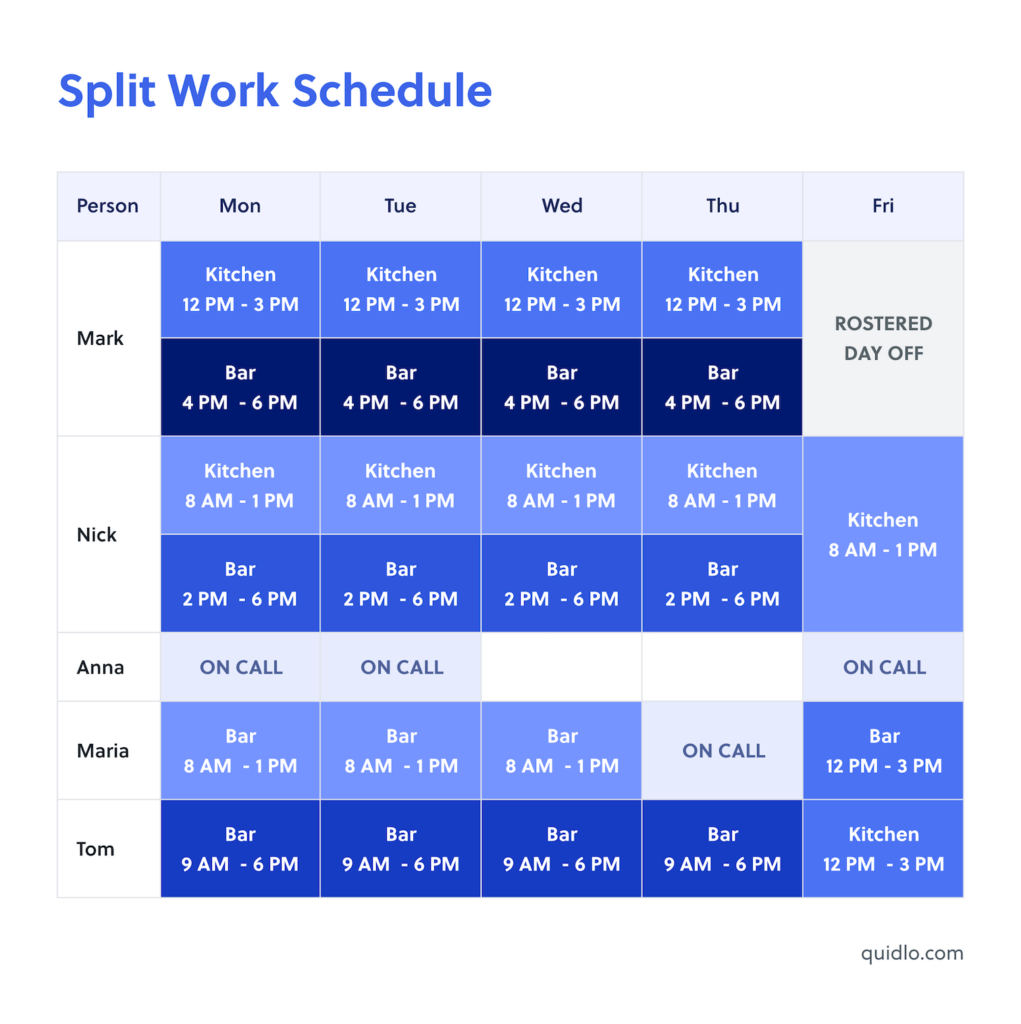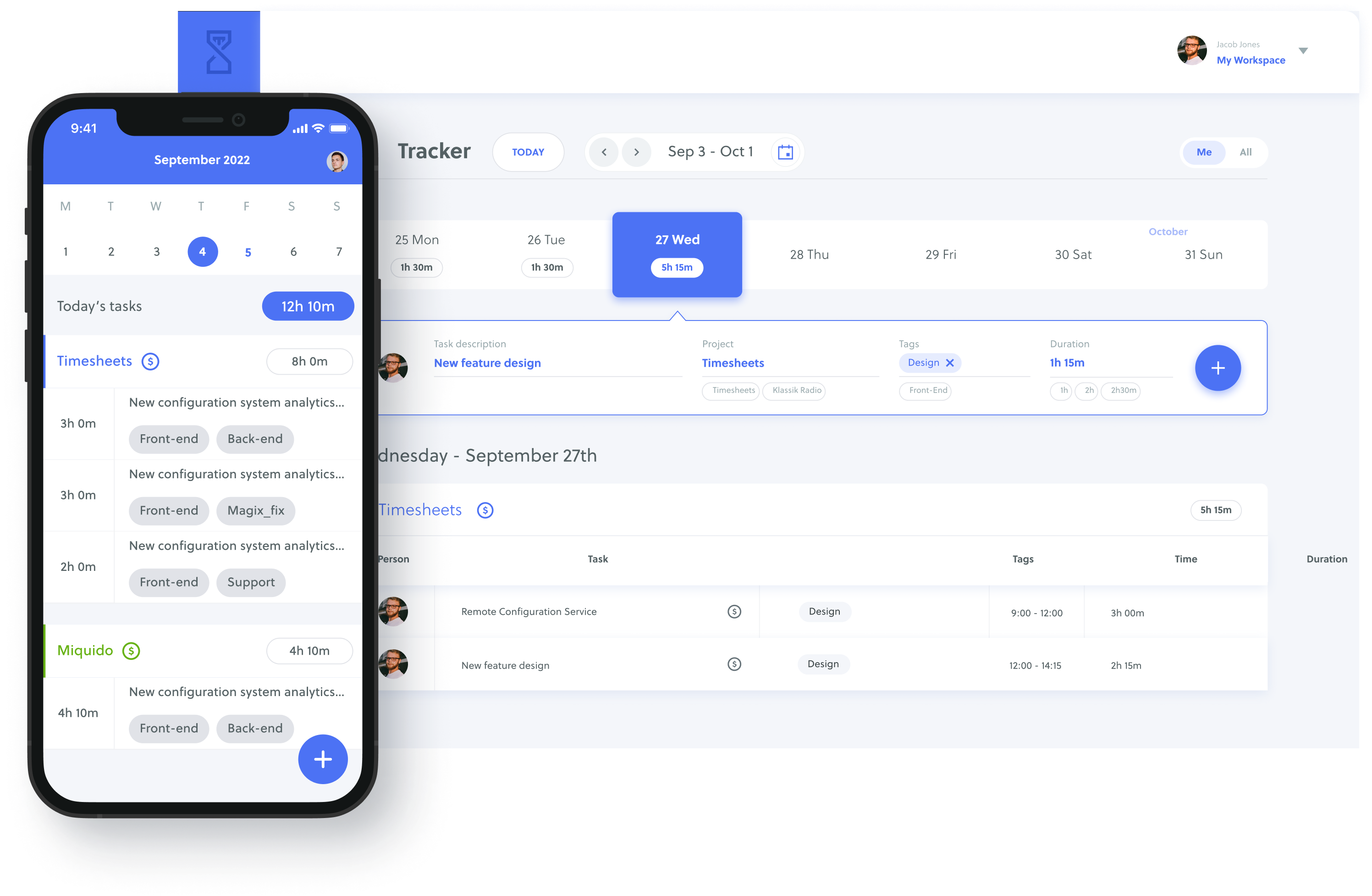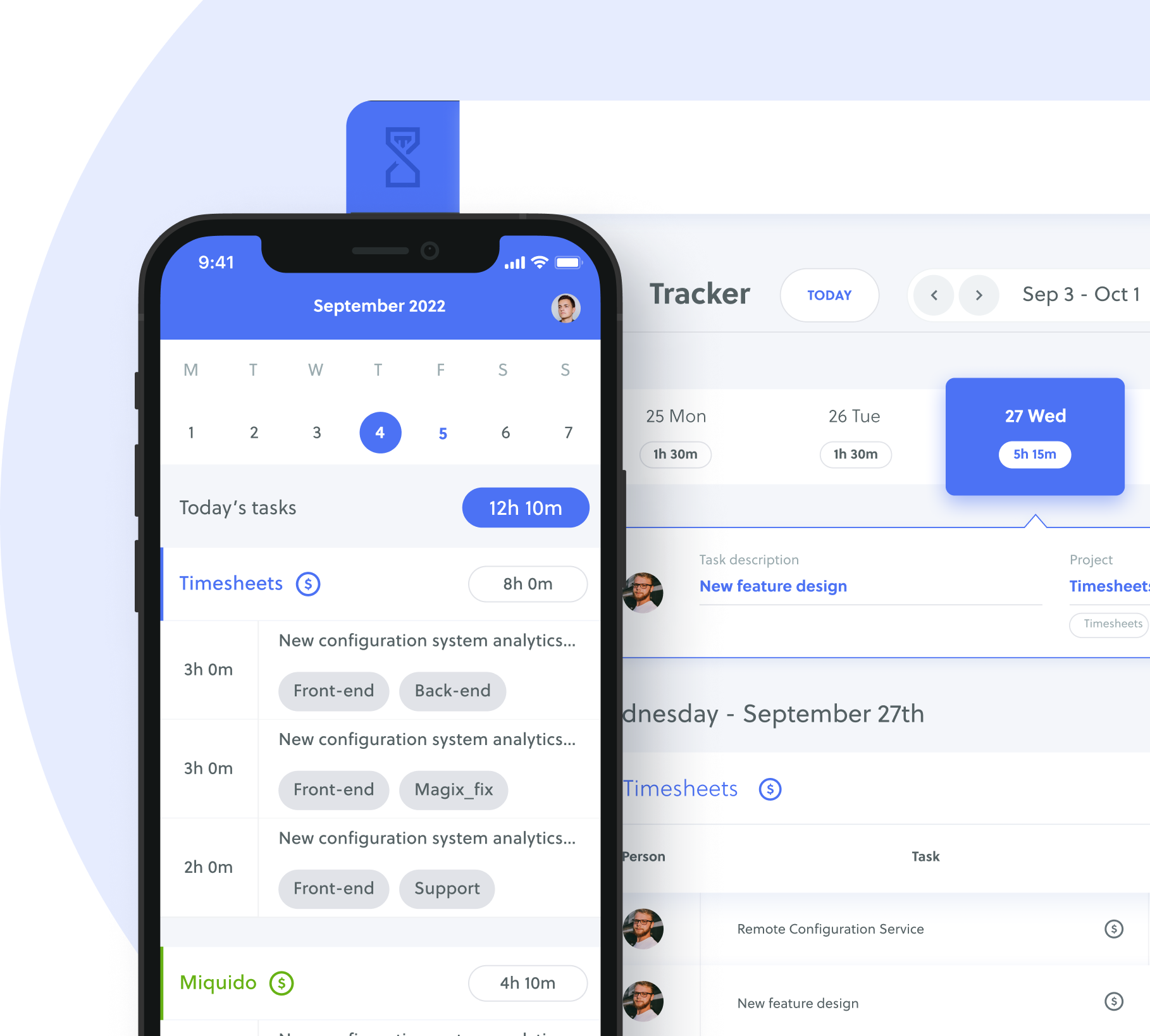If you’re in an industry that requires employees to work outside the regular 9-to-5 schedule, like hospitality, public transport, food service, medical care, or customer service, then split shifts might be the perfect solution for your business. About 3% of Americans work a split shift. Split shifts can help ensure that your team has adequate coverage and still have time to rest and recover from their day-to-day duties.
This type of flexible work arrangement not only helps strike a better balance between career and life goals, it’s also an effective way to increase overall productivity.
In this blog post, we’re sharing what exactly split shift schedules are and how they can benefit both workers and businesses alike. Keep reading to learn more!
Table of Contents
What Is a Split Shift Schedule?
A split shift schedule is a type of work arrangement that divides an employee’s hours into two shifts with a period of unpaid break in between. This type of scheduling has been employed in various industries since the early 19th century, with its popularity increasing in the 1990s.
The purpose behind this arrangement is to maximize efficiency and reduce labor costs by ensuring there are enough trained employees available when needed, without having to pay for long hours or additional staff.
While not suitable for all types of businesses, this kind of schedule may offer some unique benefits that make it worth considering in certain circumstances – particularly where customer demand needs flexible management or team members need to be added freedom around their working patterns.
Who Uses Split Shift?
Split shifts are an increasingly popular way of managing working hours and providing flexible employment opportunities. This type of shift works especially well in industries where there is a high demand for different types of work, such that it isn’t possible to adequately staff a workplace with full or part-time employees on a traditional 9-5 basis.
Following industries use split shift work schedule:
- Healthcare Professionals
- Hospitality Industry
- Retail Businesses
- Transport Companies
- Customer Support
- Security
How Does It Work in Practice?
Split shift schedules are common in industries that require round-the-clock services, such as healthcare, hospitality, and retail. In these industries, employers create a split shift schedule when they need to fill shifts at multiple times throughout the day and night.
For instance, imagine that you own a tech company with products that require customer support. The customer service team offers 24/7 support, but the hours between 8 pm and 12 am are fairly slow for customer calls due to the time difference between certain countries. To make the best use of your employees’ time and optimize their productivity, you decide to implement a split shift schedule.
Your most experienced customer service agents can work from 8 am to 12 pm and then again from 3 pm until 8 pm, allowing them to take a legally-required meal period somewhere during their working hours.
During this time, they can handle more complex customer inquiries while providing the best possible service to your customers. You can then use less experienced representatives or those with less technical expertise to cover the slower periods in the afternoon shift when there are fewer customer calls.
This will allow them to gain experience as well as practice their skills in handling customer inquiries without feeling overwhelmed by too many complex requests at once.
By using a split shift schedule for your customer service team, you can take advantage of peak times and ensure that your customers always receive top-notch support no matter the time of day.

How To Split Work Hours?
Splitting work hours can be a tricky feat, but when done successfully, it can be an incredibly rewarding experience. When considering employee scheduling, it is essential to take into account peak business hours to ensure that there is an adequate number of staff members on hand to assist customers.
This can be achieved through a thorough understanding of the company’s specific needs and demands during these times. However, it is also beneficial to consider individual team members’ needs too in order to create a schedule that both suits the business and their personnel.
Those employees with young children may appreciate having a break at around 2 or 3 pm in order for them to be able to collect their children from school, as well as ensure they can spend some quality time together. Alternatively, employees with lengthy commutes may find a split shift less than ideal due to having multiple daily journeys back and forth from home to work; this could end up taking up several hours out of their day in total.
These points should be taken into consideration when making any major changes to the scheduling system, such as introducing split shifts or other variations in hours worked.
How Are Hours Calculated?
Split shifts can present some unique challenges in calculating the total number of hours worked. To ensure that every employee’s hours are tracked accurately and fairly, it is essential to establish clear policies for how split shifts are handled.
Typically, when an employee works a split shift in one day their total hours worked should still reflect the total number of hours they were scheduled to work. For example, if a worker is scheduled for 8am to 12pm followed by 4pm to 8pm, they should be logged as having worked 8 full hours that day even though the shift was broken up into two parts.
Knowing this makes it easier for employers to know exactly how many hours their employees are working on any given day so they can always stay compliant with federal labor laws and regulations.
How Is Employee Pay Calculated?
In order to accurately calculate employee pay, employers should ensure that all break times between shifts are recorded and documented correctly.
For example, if an employee works a split shift of 8 hours in the morning and 4 hours in the afternoon, they should receive two separate payments: one for the 8 hour morning shift and another for the 4 hour afternoon shift. Depending on their employment terms, this could mean one payment at an hourly rate plus any applicable commission; or it could be two separate payments depending on the exact structure of their contract.
As an employer, it is your responsibility to ensure that all employees are paid correctly for their work. Taking time to thoroughly assess each individual’s working patterns can help prevent any discrepancies between what was promised and what actually gets paid out.
Is Split Shift Better Suited for Full-time or Part-time Employees?
A split shift is a type of work schedule that may be used in various industries, and it can apply to either part-time or full-time employees. This type of scheduling allows employees to have more flexibility in their hours, as they will typically be working two shifts instead of one.
Is It for Part Time Only?
No, split shifts are not limited to part-time workers. Both full-time and part-time employees can work split shifts. However, it is important to note that not all jobs are suitable for a split shift schedule. Some jobs require longer hours or specific duties in order for them to be done properly, so if the job cannot accommodate this type of scheduling then it will not likely be an option.
Is It a Flexible Schedule?
Yes, split shift schedules are very flexible when compared to traditional nine-to-five schedules. This flexibility allows employers to give their employees the freedom to choose when they would like to work during the day.
For example, an employee might choose to work from 9 am until 2 pm on one day and then 4 pm until 8 pm on another day, allowing them time off in between the two shifts that they can use however they wish.
How Does It Work For Full Time Employees?
For full-time employees who work a standard five days per week, a split shift schedule works by having them work three days during one period (e.g., Monday through Wednesday) and two days during another (e.g., Thursday and Friday).
During the first period, each day would still involve eight hours of work with a lunch break in between; however, during the second period only four hours would need to be worked per day due to the shorter shift duration.
This would result in 40 total hours being worked each week as opposed to 40 regular hours without any breaks or modifications.
Additionally, many employers offer additional split shift pay for those scheduling split shifts since it often requires greater effort than regular nine-to-five hours do.
What Are the Benefits of Split Shift?
The benefits of split shift are as follows:
From an Employee Perspective:
1. Split shifts can help increase employee productivity and motivation: Since employees are only working part of the day, they can focus on the task at hand with fewer distractions and distractions than if they were working a full shift. This can lead to higher quality work in less time.
2. Improved Working Conditions: Working split shifts can be beneficial for employees because it means they get some rest throughout the day which helps them to stay alert and productive during their hours of work. It also reduces stress from having to work long hours without any breaks as well as reducing fatigue due to lack of sleep.
3. Financial Incentives: For many employees, especially those in lower-wage jobs, switching to a split-shift schedule often comes with financial incentives such as bonuses or additional pay for working the second half of the shift. This could be especially beneficial for those looking to supplement their income or save up money for future goals while still having enough time off to take care of other responsibilities outside of work.
From a Manager Perspective:
1. Labor Cost Savings: One advantage of split shifts is that it allows employers to reduce labor costs by spreading out staffing needs across two different times instead of having one longer shift all throughout the day. This saves companies money on wages, payroll taxes, benefits, etc., while still providing adequate coverage when needed.
2. Improved Scheduling Efficiency: With two shorter shifts instead of one long one, managers have more control over scheduling and staffing needs throughout the day which makes it easier to manage tasks and ensure all areas are adequately staffed when needed without overstaffing or understaffing.
3. Flexibility & Control Over Work Hours: A split-shift schedule also provides managers with more flexibility when it comes to setting employee work hours since it allows them to adjust schedules based on need without needing approval from higher-level personnel or disrupting all staff’s existing schedules in order accommodate new requests for coverage or additional staffing needs during peak times.
Limitations of Split Shift Schedule
Split shift schedules can offer many advantages to employers and employees alike, but they come with some drawbacks as well. Here are 4 of the most common limitations of split shift schedules.
Loss of Productivity
When employees are working split shifts, they often end up having longer days than if they were on a traditional shift schedule. This means that employees may be more tired throughout their day and this can lead to a decrease in productivity levels.
Increased Stress Levels
Working split shifts can be very stressful for employees due to the lack of predictability when it comes to their hours and schedules.
For example, if an employee is scheduled for a morning shift one day and then an evening shift the next day it can be difficult to plan any meals or activities in between these shifts since they will likely have no idea what time they will start or finish work until the last minute.
Lower Morale
Split shifts often require employees to come into work earlier in the morning or stay later at night than they would on a regular shift schedule which can make it difficult for them to maintain healthy routines outside of work hours such as exercising or spending time with family and friends.
This lack of balance between work life and home life can lead to feelings of exhaustion which lowers morale in the workplace as well as overall job satisfaction levels among staff members.
Split Shift Legal Rules in USA
Split shifts can be a tricky subject when it comes to employment law, as the rules can vary depending on the state you live in and the specific circumstances of your job. Let’s delve into the legalities of split shifts in the USA
California
Here are some of the split shifts legal rules in California:
- Employers must pay their employees the split shift premiums for each workday that includes a split shift.
- The split shift premium is one hour at the state minimum wage, or the local minimum wage, if there is one, whichever is greater.
- The split shift scheduling premium does not apply to exempt employees, employees covered by a collective bargaining agreement or employees who have agreed to a voluntary split shift schedule in writing.
Illinois
In Illinois, there are no special local and federal laws about schedule split shifts. But, the state’s Department of Labor does have a rule that says employers have to pay their employees for any time they work. This includes time spent working a split shift.
So, if you work a split shift in Illinois, your employer has to pay you hourly minimum wage for all the hours you worked, no matter how long the break or breaks were between shifts.
New York
You are entitled to an additional hour of pay every day, at the New York State Minimum Wage hourly rate, if your hours of work are “split” (not consecutive) or if your shift lasts more than ten hours.
District of Columbia
According to the federal laws, companies must pay workers an extra hour for every day that they perform split shifts.
Florida
According to the Florida Department of Business and Professional Regulation (DBPR), if you’re working a split shift and your employer gives you less than an hour to rest, they owe you an extra hour’s pay at the minimum wage rate.
Texas
Don’t let your boss shortchange you on your pay just because you’re working a split shift in Texas! According to the state’s Workforce Commission, employers are required to pay for employee’s workday on split shifts work, no matter how many breaks or shifts are involved.
Alternatives to Split Shift Schedule
4/10 Work Schedule
The 4/10 work schedule is an alternative to the split shift work schedule that allows employees to work four 10-hour days per week. This compressed workweek schedule can make it easier for workers to maintain a healthy work-life balance, as they have three full days off during the week.
9/80 Work Schedule
The 9/80 work schedule offers an alternative to the split shift schedule by allowing employees to work nine hours per day over a two-week period, instead of eight hours per day over five days. This compressed workweek gives employees an extra day off each week while maintaining their traditional five-day schedules.
2-2-3 Work Schedule
The 2-2-3 schedule is another option available in place of a split shift. Employees would be scheduled for two consecutive days of 12 hour shifts followed by two consecutive days off and then three consecutive 12 hour shifts followed by three consecutive days off.
Flexible Scheduling
While not necessarily an “alternative”, flexible scheduling provides workers with autonomy over their own schedules by allowing them control over when they come in/leave work (within reason) as well as giving them options regarding how much they choose to work overall within a given period of time (full-time vs part-time etc)
Split Shift Schedule Might Be Right for Your Business
In conclusion, a split shift schedule can be beneficial for businesses looking to maximize productivity and efficiency. It allows for fewer employees to work with one of them being able to complete tasks that would normally require two people.
Split shift scheduling also creates an opportunity for businesses to take advantage of peak demand periods, enabling them to increase customer satisfaction by providing better service during these times.
However, it is important to carefully consider the effects on employee morale before implementing a split shift schedule in order to ensure that the benefits outweigh any potential drawbacks. Additionally, employers should strive to make the most out of split shifts by scheduling breaks and down time strategically so that employees are able to remain productive throughout their shifts without feeling overworked or burned out.
With the right approach and thoughtful consideration of how it will affect your business, a split shift schedule could prove to be an effective strategy for success.







